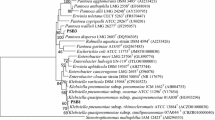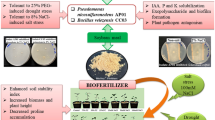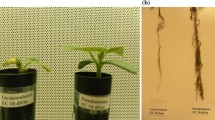Abstract
The absence of phytotoxicity is one of the most important criterions for the use of biofertilizers, and their carriers must be able to maintain their activity efficiently until used. Hence, a carrier that consisted of a mixture of rice straw and rice husk ash in a 4:1 ratio with potential biofertilizers (Rhodopseudomonas palustris TK103, PP803, and P1) were investigated with a salt sensitive rice for seed germination assay and the efficacy of the biofertilizers to ameliorate rice growth under salt stress (0.25 % NaCl) by producing 5-aminolevulinic acid (ALA) and reducing gas emissions (CH4 and CO2). No phytotoxicity was found under optimal concentrations for any of the biofertilizers tested as the germination index (GI) in the range of 105–117 %; however, the carrier had a 94 % GI when compared with distilled water. Among the biofertilizers tested, strain PP803 was the best to ameliorate rice seedling growth in soil under salt stress, particularly on plant height and root length when compared with carrier and water controls. In a paddy field model study under microaerobic light conditions for 10 days, optimal concentrations of biofertilizers provided viable cells in the range of 6.7–6.8 log CFU mL−1 , and strain PP803 was the most effective fertilizer to produce maximum ALA (2.61 μM) and reduce 100 % CH4 and 47 % CO2 emissions. It can be concluded that the biofertilizers tested, particularly the strain PP803, could be powerful agents for use in saline paddy fields to ameliorate rice seedlings growth under salt stress and reduce greenhouse gas emissions.



Similar content being viewed by others
References
Amaral EA, Toorop PE, Nijsse J, Bewley JD, Hilgorst HWM (2005) Exogenous gibberellins inhibit coffee (Coffea Arabica cv. Rubi) seed germination and cause cell death in the embryo. J Exp Bot 56:1029–1038
Bevilaqua DB, Magale KDR, Tiele MR, André LC, Ayrton FM (2013) Cleaner production: levulinic acid from rice husks. J Clean Prod 47:96–101
Burnham BF (1970) δ-Aminolevulinic acid synthase (from Rhodopseudomonas sphaeroides). Methods Enzymol 17:195–204
Courtney R, Mullen G (2009) Use of germination and seedling performance bioassays for assessing revegetation strategies on bauxite residue. Water Air Soil Pollut 197:15–22
Das S, Adhya TK (2014) Effect of combine application of organic manure and inorganic fertilizer on methane and nitrous oxide emissions from a tropical flooded soil planted to rice. Geoderma 213:185–192
Dianou D, Miyaki T, Asakawa S, Moril H, Nagaoka K, Oyaizu H, Matsumoto S (2001) Methanoculleus chikugoensis sp. nov., a novel methanogenic archaeon isolated from paddy field soil in Japan, and DNA-DNA hybridization among Methanoculleus species. Int J Syst Evol Microbiol 51:1663–1669
Eckard RJ, Grainger C, Klein CAM (2010) Options for the abatement of methane and nitrous oxide from ruminant production: A review. Livest Sci 130:47–56
FAO (2012) Food and Agricultural Organization of the United Nations. Food Outlook, Rome
Ferreira EM, Castro IV (2005) Residues of the cork industry as carriers for the production of legumes inoculants. Silva Lusit 13:159–167
Foo K, Hameed B (2009) Utilization of rice husk ash as novel adsorbent: a judicious recycling of the colloidal agricultural waste. Adv Colloid Interface Sci 152:39–47
Fukui Y, Miki M, Ukai H, Okamoto S, Takada S, Ikeda M (2005) Comparison of colorimetric and HPLC methods for determination of delta-aminolevulinic acid in urine with reference to dose–response relationship in occupational exposure to lead. Ind Health 43:691–698
Gamal-Eldin H, Elbanna K (2011) Field evidence for the potential of Rhodobacter capsulatus as biofertilizer for flooded rice. Curr Microbiol 62:391–395
Harada N, Nishiyama M, Matsumoto S (2003) Inhibition of methanogens increases photo-dependent nitrogenase activities in anoxic paddy soil amended with rice straw. FEMS Microbiol Ecol 35:231–238
Harada N, Nishiyama M, Otsuka S, Matsumoto S (2005) Effects of inoculation of phototrophic purple bacteria on grain yield of rice and nitrogenase activity of paddy soil in a pot experiment. J Soil Sci Plant Nutr 51:361–367
Haskin C (2013) Determination of the concentration of atmospheric gases by gas chromatography. McNair Scholars Res J 6:36–52
Hoekstra NJ, Bosker T, Lantinga EA (2002) Effects of cattle dung from farms with different feeding strategies on germination and initial root growth of cress (Lepidium sativum L.). Agri Ecosyst Environ 93:189–196
Hotta Y, Tanaka T, Takaoka H, Takeuchi Y, Konnai M (1997) Promotive effects of 5-aminolevulinic acid on the yield of several crops. Plant Growth Regul 22:109–114
Kadam KL, Forrest LH, Jacobson WA (2000) Rice straw as a lignocellulosic resource: collection, processing, transportation, and environmental aspects. Biomass Bioenerg 18:369–389
Kang Z, Zhang J, Zhou J, Qi Q, Du G, Chen J (2012) Recent advances in microbial production of δ-aminolevulinic acid and vitamin B12. Biotech Adv 30:1533–1542
Kantachote D, Kornochalert N, Chaiprapat S (2010) The use of purple nonsulfur bacterium isolate P1 and fermented pineapple extract to treat latex rubber sheet wastewater for possible use as irrigation water. Afr J Microbiol Res 4:2604–2616
Kantha T, Chaiyasut C, Kantachote D, Sukrong S, Muangprom A (2010) Selection of photosynthetic bacteria producing 5-aminolevulinic acid from soil of organic saline paddy fields from the Northeast region of Thailand. Afr J Microbiol Res 4:1848–1855
Kapanen A, Itavaara M (2001) Ecotoxicity tests for compost applications. Ecotoxicol Environ Saf 49:1–16
Khalid N, Khalid H, Abdul M, Farah K, Shahid A, Kazim A (2010) Fatality of salt stress to plants: Morphological, physiological and biochemical aspects. Afr J Biotechnol 9:5475–5480
Kim MK, Choi KM, Yin CR, Lee KY, Im WT, Lim JH, Lee ST (2004) Odorous swine wastewater treatment by purple non-sulfur bacteria, Rhodopseudomonas palustris, isolated from eutrophicated ponds. Biotech Lett 26:819–822
Kobayashi M, Haque MZ (1971) Contribution to nitrogen fixation and soil fertility by photosynthetic bacteria. Plant Soil 35:443–456
Koh RH, Song HG (2007) Effects of application of Rhodopseudomonas sp. on seed germination and growth of tomato under axenic conditions. J Microbiol Biotech 17:1805–1810
Kornochalert N, Kantachote D, Chaiprapat S, Techkarnjanaruk S (2014) Use of Rhodopseudomonas palustris P1 stimulated growth by fermented pineapple extract to treat latex rubber sheet wastewater to obtain single cell protein. Ann Microbiol 64:1021–1032
Lorlowhakarn S, Boonyanopakun K, Ellis W, Panyakul V, Vildozo V, Kasterine A (2008) Strengthening the Export Capacity of Thailand’s Organic Agriculture. National Innovation Agency (NIA), Bangkok
Mishra A, Salokhe VM (2011) Rice root growth and physiological responses to SRI water management and implications for crop productivity. Paddy Water Environ 9:41–52
Nakhoda B, Leung H, Mendioro MS, Nejad GM, Ismail AM (2012) Isolation, characterization, and field evaluation of rice (Oryza sativa L., Var. IR64) mutants with altered responses to salt stress. Field Crops Res 127:191–202
Nunkaew T, Kantachote D, Nitoda T, Kanzaki H (2012) The use of rice straw broth as an appropriate medium to isolate purple nonsulfur bacteria from paddy fields. Electron J Biotechn. doi:10.2225/vol15-issue6-fulltext-9
Nunkaew T, Kantachote D, Nitoda T, Kanzaki H, Ritchie RJ (2014) Effects of 5-aminolevulinic acid (ALA)-containing supernatants from selected Rhodopseudomonas palustris strains on rice growth under NaCl stress, with mediating effects on chlorophyll, photosynthetic electron transport and antioxidative enzymes. Electron J Biotechn 17:19–26
Nunkaew T, Kantachote D, Nitoda T, Kanzaki H (2015) Selection of salt tolerant purple nonsulfur bacteria producing 5-aminolevulinic acid (ALA) and reducing methane emissions from microbial rice straw degradation. Appl Soil Ecol 86:113–120
Panwichian S, Kantachote D, Wittayaweerasak B, Mallavarapu M (2010a) Isolation of purple nonsulfur bacteria for the removal of heavy metals and sodium from contaminated shrimp ponds. Electron J Biotechn. doi:10.2225/vol13-issue4- fulltext-8
Panwichian S, Kantachote D, Wittayaweerasak B, Mallavarapu M (2010b) Factors affecting immobilization of heavy metals by purple nonsulfur bacteria isolated from contaminated shrimp ponds. World J Microbiol Biotechnol 26:2199–2210
Prades A, Dornier M, Diop N, Pain JP (2011) Coconut water uses, composition and properties: a review. Fruits 67:87–107
Rabia B, Shamim AQ (2014) Composted rice husk improves the growth and biochemical parameters of sunflower plants. J Bot. doi:10.1155/2014/427648
Rajagopal B, Belay S, Daniels N (1988) Isolation and characterization of methanogenic bacteria from rice paddies. FEMS Microbiol Lett 53:153–158
Sahi C, Singh A, Blumwald E, Grover A (2006) Beyond osmolytes and transporters: novel plant salt stress tolerance-related genes from transcriptional profiling data. Plant Physiol 127:1–9
Sasaki K, Watanabe M, Tanaka T, Tanaka T (2002) Biosynthesis, biotechnological production and applications of 5-aminolevulinic acid. Appl Microbiol Biotechnol 58:23–29
Tangprasittipap A, Prasertsan P, Choorit W, Sasaki K (2007) Biosynthesis of intracellular 5-aminolevulinic acid by a newly identified halotolerant Rhodobacter sphaeroides. Biotechnol Lett 29:773–777
Verburg PH, Hugo AC (2001) Spatial and temporal dynamics of methane emissions from agricultural sources in China. Glob Chang Biol 7:31–47
Vessey JK (2003) Plant growth promoting rhizobacteria as bio-fertilizers. Plant Soil 255:571–586
Wang X, Sun C, Gao S, Wand L, Shoukui H (2001) Validation of germination rate and root elongation as indicator to assess phytotoxicity with Cucumis sativus. Chemosphere 44:1711–1721
Yan X, Akiyama H, Yagi K (2009) Global estimations of the inventory and mitigation potential of methane emissions from rice cultivation conducted using the 2006 Intergovernmental Panel on Climate Change Guidelines. Glob Biogeochem Cy 23:1–15
Yunchen Z, Ping W, Li J, Chen Y, Ying X, Liu L (2009) The effects of two organic manures on soil properties and crop yields on a temperate calcareous soil under a wheat–maize cropping system. Eur J Agron 31:36–42
Acknowledgments
Financial support for this study was provided by Postdoctoral Fellowship Program, Prince of Songkla University (PSU) for the fiscal year 2012 and the research grant no. SCI550313S, PSU. We gratefully thank Dr. Brian Hodgson for his assistance with English.
Author information
Authors and Affiliations
Corresponding author
Rights and permissions
About this article
Cite this article
Kantha, T., Kantachote, D. & Klongdee, N. Potential of biofertilizers from selected Rhodopseudomonas palustris strains to assist rice (Oryza sativa L. subsp. indica) growth under salt stress and to reduce greenhouse gas emissions. Ann Microbiol 65, 2109–2118 (2015). https://doi.org/10.1007/s13213-015-1049-6
Received:
Accepted:
Published:
Issue Date:
DOI: https://doi.org/10.1007/s13213-015-1049-6




